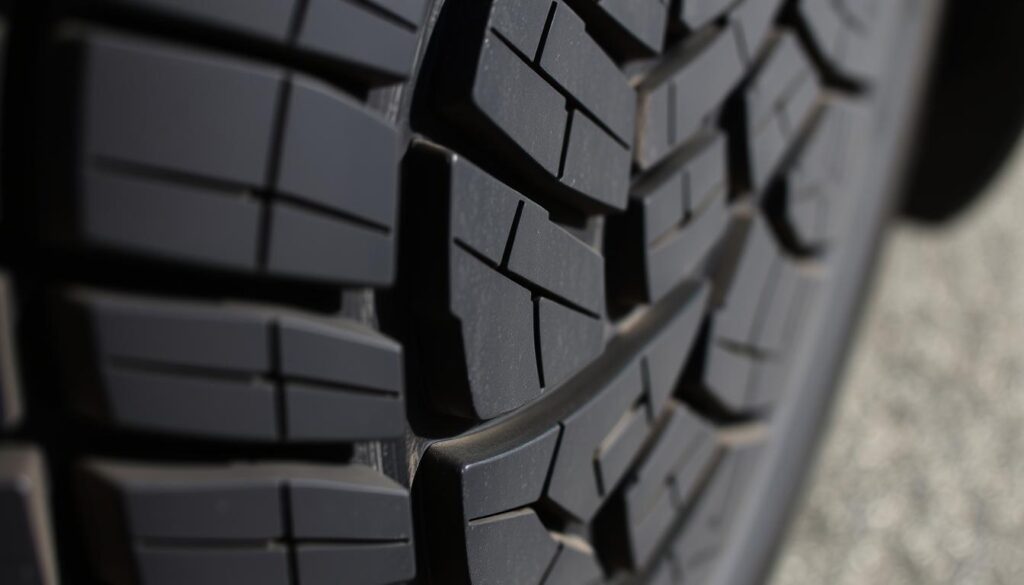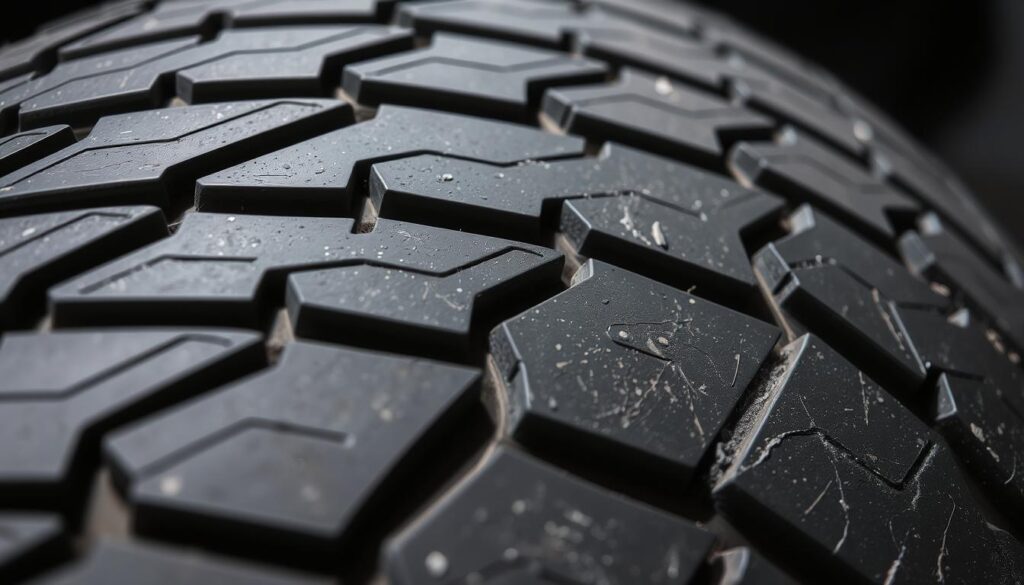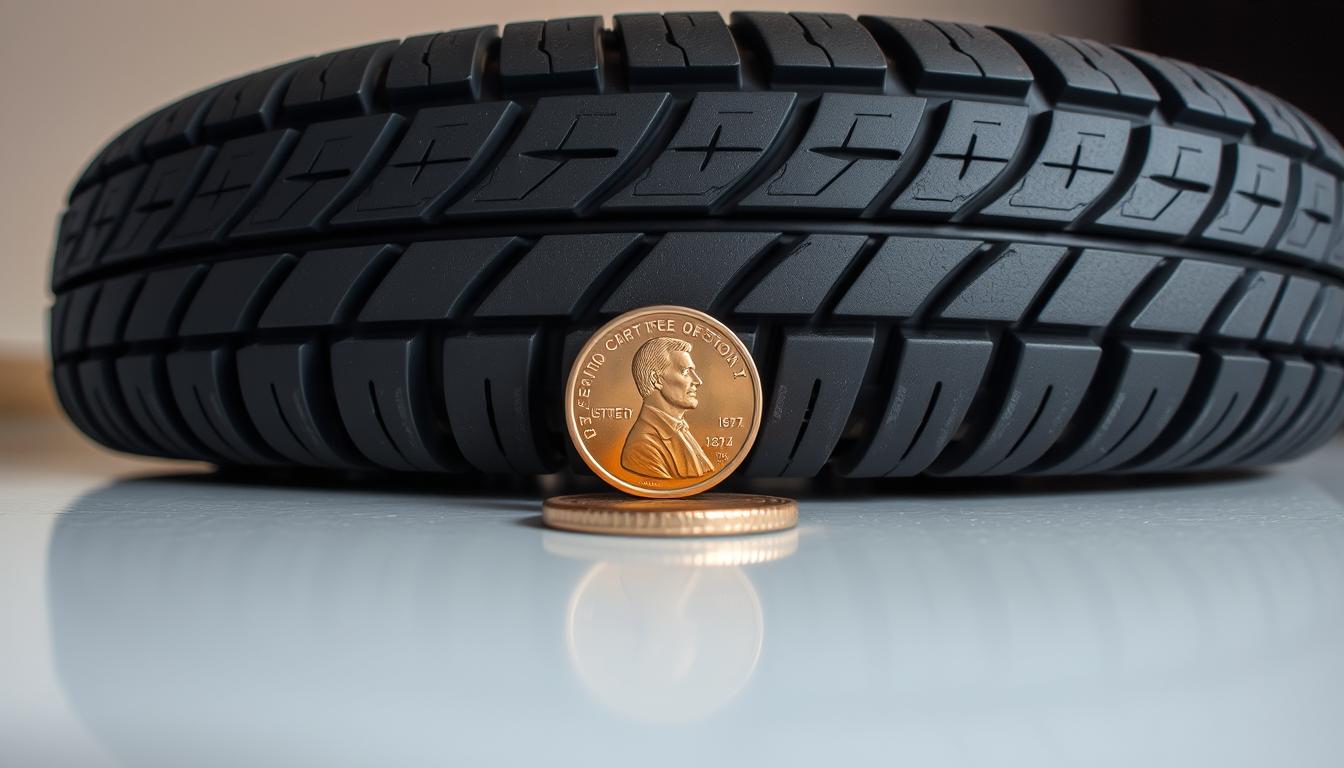Keeping your vehicle’s tire tread depth in check is key for safety and performance. We know how vital it is to make sure your tires are in top shape. So, we’re here to show you a simple way to check tire tread depth with the penny test.
The penny test is easy to use to see if your tire tread is too thin. Just put a penny into the tire groove with Lincoln’s head down. If you can see the top of his head, it’s time to think about getting new tires.
Regularly checking tire tread depth can really help your car’s handling and stopping power. We suggest adding this to your list of things to check on your car to stay safe on the road.
Key Takeaways
- Use the penny test to check tire tread depth.
- Insert the penny with Lincoln’s head facing down into the tire groove.
- If the top of Lincoln’s head is visible, your tread is worn out.
- Regular checks can improve vehicle safety and performance.
- Maintaining adequate tire tread depth is vital for safe driving.
Why Tire Tread Depth Matters for Your Safety
Tire tread depth is key for vehicle safety. It’s not just a number; it’s a safety feature. Tires are vital for our vehicle’s performance.
The Role of Tire Tread in Vehicle Performance
Tire tread depth affects how your vehicle handles roads. A deeper tread means better grip and traction. This is important for control, even on slippery roads.
How Tread Depth Affects Braking Distance
Tire tread depth impacts braking distance. Worn-out tread can’t stop as fast. The U.S. Department of Transportation says tires should be replaced at 2/32” tread depth.
Traction in Wet and Winter Conditions
Tire tread depth is critical in wet and winter conditions. Worn-out tires can hydroplane on wet roads. This makes steering and braking hard.
In winter, enough tread depth keeps traction on snowy and icy roads. This reduces skidding risk.
Knowing the importance of tire tread depth helps keep us safe. Regular checks and maintenance are key for road safety.
Understanding Tire Tread Measurements and Patterns
Knowing about tire tread depth and patterns is key for your vehicle’s health. It’s not just about looks; it’s vital for safety and performance.
Standard Tread Depth Measurements
Tire tread depth is measured in 32nds of an inch. New tires usually have 10/32” or 11/32” tread. As you drive, this depth goes down. Standard tread depth measurements show how much tread is left and when to replace tires.
Common Tire Tread Patterns and Their Purposes
Tire tread patterns improve traction, handling, and safety. You’ll find:
- Symmetric tread patterns for everyday driving
- Directional tread patterns for better traction in wet conditions
- Asymmetric tread patterns for better handling and braking
Legal Minimum Requirements in the United States
In many states, the legal minimum tread depth is 2/32”. Driving with tires this low can cause fines and accidents. It’s important to check your tire tread often to follow these rules.
Manufacturer Recommendations
While there are legal minimums, tire makers have their own rules for when to replace tires. Some say to replace tires at 4/32” or less, for driving in bad weather. Always look at your vehicle’s manual or talk to the maker for specific advice.
Understanding tire tread measurements and patterns helps you make smart choices for your vehicle. Regular checks and timely replacements are essential for your vehicle’s best performance and safety.
The Penny Test: A Simple Way to Check Tire Tread
The penny test is a simple way to check if your tires need to be replaced. It’s a trusted DIY method that’s been around for years. It helps you quickly see if your tire tread is too thin.
What You’ll Need
To do the penny test, you just need a penny with Lincoln’s head on it. It’s easy to use, making it accessible to everyone.
The Lincoln Head Penny Method
Put the penny into the tire groove with Lincoln’s head down. If you can see the top of his head, your tread is too thin. This means it’s time to think about getting new tires.
Interpreting Your Results
If the tread covers Lincoln’s head, your tires are fine for now. But if you can see his head, it’s a sign your tires are almost gone. It’s important to check different spots on each tire to get a true reading. Tread wear can be uneven.
Frequency of Testing
It’s a good idea to check your tire tread often. Do it during routine checks or when you notice your car handles differently. “Regular checks can prevent accidents from worn-out tires,” safety experts say. Using the penny test every few months keeps your tires in good shape.
How to Check Tire Tread Using the Penny Test: Step-by-Step Guide

We’ll show you how to check your tire tread with the penny test. This easy method tells you if your tires are safe for driving.
Preparing Your Vehicle
First, park your car on a flat surface. This is key for a correct reading. Turn off the engine and apply the parking brake for safety.
Positioning the Penny Correctly
Place a penny in the tire groove with Lincoln’s head down. The penny test quickly shows your tire’s tread depth. If Lincoln’s head is visible, your tread is too thin, at 2/32″ or less.
Checking Multiple Points on Each Tire
To accurately check your tire, examine different spots on each tire. Uneven wear can happen due to misalignment or wrong inflation. So, check both the center and edges.
Recording Your Findings
Write down the tread depth for each tire at various spots. This helps spot any uneven wear. A table can help organize this information.
| Tire Position | Tread Depth (in/32″) | Notes |
|---|---|---|
| Front Left | 5 | Even wear |
| Front Right | 4 | Some uneven wear |
| Rear Left | 6 | Even wear |
| Rear Right | 3 | Significant uneven wear |
By following these steps, you can easily check your tire tread depth with the penny test. Regular checks keep your vehicle safe and running well.
Alternative Methods to Check Tire Tread Depth
There are many ways to check your tire’s tread depth, not just the penny test. You can use special tools or built-in indicators. These methods are more precise or easier to use than the penny test.
Using a Tire Tread Depth Gauge
A tire tread depth gauge is a handy tool for measuring tread depth. Just stick it into the tire groove and read the measurement. It’s more accurate than the penny test and works on different parts of the tire.
The Quarter Test Method
The quarter test is like the penny test but uses a quarter. Place it in the tire groove with Washington’s head down. If you see his head, your tread is about 4/32″ deep. This method is a bit more sensitive.
Built-in Tread Wear Indicators
Many tires have built-in tread wear indicators, or “tread wear bars.” These are rubber bars across the tread. When your tread is down to these bars, it’s time for new tires.
Digital Tire Depth Apps and Tools
For a tech-savvy approach, there are digital apps and tools. They use your smartphone’s camera to measure tread depth. These tools give a digital reading and are handy for those who like using their phone for everything.
Using these alternative methods helps keep your tires in good shape and safe. Regular checks are key to maintaining your vehicle and avoiding safety problems on the road.
“Regular tire maintenance is key for safety and performance. Using the right tools to check tread depth is a must.”
Understanding Tire Tread Wear Patterns
Tire tread wear patterns tell us a lot about our vehicle’s health. By looking at these patterns, we can spot issues that need fixing. This helps keep us safe on the road and keeps our vehicle in good shape.
Center Wear vs. Edge Wear
Center wear means the middle of the tire is worn down more. This usually happens if the tire is overinflated. The center takes the most road contact, wearing down faster.
Edge wear, on the other hand, shows if the tires are underinflated. This can make the tires use more fuel and increase the risk of a blowout.
Uneven Wear Patterns
Uneven wear can point to bigger problems like wheel misalignment or suspension issues. If the tires are not aligned right, they wear down unevenly. This can make the car pull to one side and reduce traction.
Suspension problems also affect how the tires hit the road. This can cause uneven wear too.
What Your Tread Wear Reveals About Your Vehicle
The wear pattern on your tires can tell you a lot about your vehicle. If one tire wears down faster, it might mean there’s a problem with the wheel alignment or camber. Checking your tire tread regularly can help you catch these issues early. This can save you from expensive repairs later.
Diagnosing Suspension and Alignment Issues
Looking closely at your tire tread wear can help you find suspension and alignment problems. For example, feathering – where one edge of the tread is more worn – can mean the toe alignment is off. Fixing these issues quickly can make your tires last longer and keep your car safe to drive.
Understanding tire tread wear patterns is key to keeping your vehicle in top shape. By spotting and fixing problems early, we can stay safe on the road and make our tires last longer.
When to Replace Your Tires Based on Tread Measurement
As your tires wear down, knowing when to replace them is key. The tread depth is a major factor in their safety and performance.
Warning Signs You Shouldn’t Ignore
There are clear signs that your tires need to be replaced. These include:
- A tread depth of 2/32” or less, as measured using the penny test or a tread depth gauge.
- Visible signs of uneven wear, such as feathering or cupping.
- Cracks in the sidewall or tread area.
If you see any of these signs, it’s time to replace your tires. This keeps your vehicle safe.
Seasonal Considerations
Seasonal changes can affect your tire condition. For example:
- Winter tires may need to be replaced more often due to harsh conditions.
- Summer tires can degrade faster in high temperatures.
Emergency Replacement vs. Planned Maintenance
While emergency tire replacement is sometimes needed, planning ahead is better. Regularly checking your tire tread depth lets you schedule replacements. This avoids the hassle and danger of a blowout.
Cost Considerations and Planning
Understanding the cost of tire replacement helps you budget. Consider the type of tires, how many you need, and any extra services like wheel alignment.
Maintaining Proper Tire Tread for Optimal Performance

Keeping your vehicle’s tire tread in good shape is key for safety and performance. There are several practices that boost your car’s performance and extend tire life.
Regular Rotation Schedule
Following a regular tire rotation schedule is a smart move. It helps your tires wear down evenly, preventing some from wearing out faster. Aim to rotate your tires every 5,000 to 8,000 miles.
Proper Inflation and Its Impact on Tread Wear
Proper tire inflation is also essential. Underinflated tires can cause uneven wear because they don’t make full contact with the road. Always check your vehicle’s manual for the right tire pressure.
Alignment and Balancing
Proper alignment and balancing of your tires are critical. Misalignment can lead to uneven wear, while imbalance causes vibrations that harm tread. Regular checks can spot and fix these problems.
Driving Habits That Preserve Tread Life
Your driving habits greatly affect tire tread. Avoiding extreme temperatures, sudden accelerations, and hard braking helps preserve tread life. Smooth driving extends your tire’s life and keeps your car running well.
- Regular tire rotation
- Proper inflation
- Alignment and balancing
- Smooth driving habits
By sticking to these tips, you can keep your tires in top shape. This boosts both safety and performance.
Tire Tread Indicators and Safety Features
It’s important to know about tire tread indicators for your safety. These indicators show when your tires need to be replaced. They alert you when the tread has worn down too much.
Understanding Built-in Tread Wear Indicators
Most tires today have built-in tread wear indicators, or wear bars. These small bars in the tire grooves show when the tread is low. When the tread meets these bars, it’s time for new tires.
Modern Tire Technology and Safety Features
Modern tires have many safety features. They improve traction and handling. This makes your car perform better, whether it’s dry or wet outside.
How Manufacturers Design Tires for Wear Visibility
Tire makers design tires to show when they’re worn. They use tread wear indicators and special tread patterns. These help with water evacuation and prevent hydroplaning.
Reading Tire Date Codes and Age Indicators
It’s also key to check the age of your tires. The date codes on the sidewall tell you when they were made. Knowing this helps you see if your tires are too old, even if they look good.
By watching for tire tread indicators and other safety features, you keep your car safe. Regular checks and care extend your tires’ life. This keeps you safe on the road.
Conclusion: Keeping Your Tires Safe and Legal
Keeping your tire tread depth at the right level is key for tire safety and following the law. We’ve looked at ways to check tire tread depth, like the penny test and using a tire tread depth gauge. Regular checks and upkeep keep your tires safe and legal.
Understanding tire tread wear patterns and knowing when to replace tires boosts your car’s performance and safety. We suggest making tire care a regular part of your car’s maintenance routine.
For your safety on the roads, focus on tire safety. Check your tire tread depth often and take good care of your tires. This can greatly improve your driving experience. Take charge of your vehicle’s upkeep today.
FAQ
What is the minimum legal tire tread depth in the United States?
In the United States, the minimum legal tire tread depth is 2/32″ (1.6 mm). It’s also wise to replace tires at this depth for safety.
How often should I check my tire tread depth?
Check your tire tread depth at least once a month. Also, do it before long trips to make sure your tires are safe and legal.
Can I use the penny test on all types of tires?
Yes, the penny test works for most tire types. But, a tire tread depth gauge is more accurate.
What are the signs of uneven tire tread wear?
Uneven wear signs include center wear, edge wear, and patterns. These can mean issues with your vehicle’s suspension, alignment, or inflation.
How can I maintain proper tire tread for optimal performance?
For good tire tread, rotate tires regularly. Also, keep them properly inflated, aligned, and balanced. Drive carefully to preserve tread life.
What are built-in tread wear indicators, and how do they work?
Built-in tread wear indicators are small bars in the tread. They show when the tread is worn down to a certain depth, meaning it’s time for new tires.
Can I use a digital app to check my tire tread depth?
Yes, digital apps can check tire tread depth with your smartphone’s camera. But, their accuracy can vary.
How does tire tread depth affect my vehicle’s braking distance?
Tire tread depth is key for braking distance. Worn-out tires can make stopping longer, which is risky, on wet or slippery roads.
What is the difference between emergency replacement and planned maintenance for tires?
Emergency replacement is urgent, like for a flat or damaged tire. Planned maintenance is scheduling a replacement at a good time, based on tread wear and other factors.
How do I read tire date codes and age indicators?
Tire date codes and age indicators are on the sidewall. They tell you the tire’s manufacturing date and age, helping you know when to replace them.
Recent Posts
Cold-Weather Driving Essentials: Top Gloves for Safe Winter Travel
Keep your hands warm and your steering wheel secure this winter with our top glove picks. Discover the best options for safe and comfortable cold-weather driving!
Tesla Roof Rack Storage: Ultimate Guide to Secure and Versatile Cargo Solutions
Tesla roof rack storage offers extra space to carry luggage and gear securely on your Model Y. These racks fit various needs, from bikes to kayaks, making travel easier. ...


